
Recommended Reading
Recommended Reading There is no single preferred way to prepare for Egypt. Many like to read everythingthey can that’s relevant in advance; others prefer to
The sequence of events listed in this itinerary is typical but not absolutely specific; the order may change from trip to trip depending upon local exigencies, unavoidable schedule changes, etc. But we visit all the sites listed, conditions permitting.
Shorter or longer private tours with John Anthony West are possible by arrangement
PDF version of Magical Egypt Tours itinerary
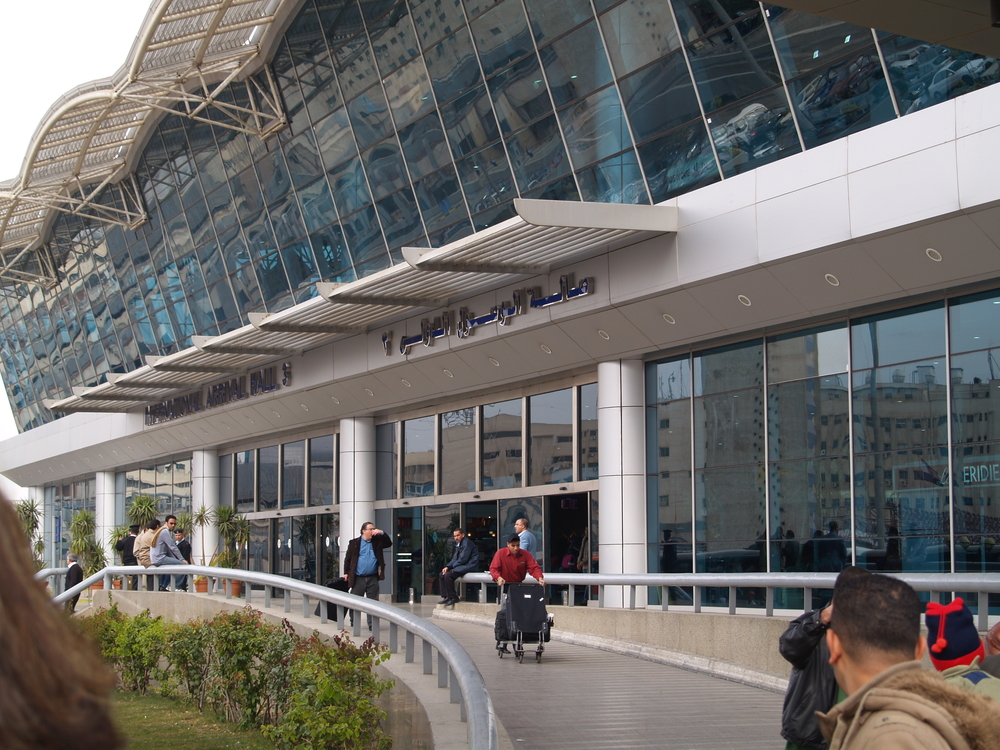
6:30 PM
Typical departure time from New York JFK. Check in to your airline at least 3 hours prior to departure time. Prior to departure check up-to-the-moment security regulations.

12:30 PM (EST + 7)
Anyone arriving on this day will be met at the airport by a Quest Travel Representative, shepherded through customs, and taken to our hotel at no extra charge. For those arriving on another day, there is a $40 per person extra charge (well worth it to avoid the hassle of hiring a taxi.) Your visa may be obtained at the airport ($15 usually, but may be a different price depending upon country of passport origin)
Depending upon traffic, it’s roughly an hour to our Mena House Hotel in Giza, a stone’s throw from the Great Pyramid.Check in. The rest of the day is free.HOWEVER, you should look for a flight that arrives in Cairo sometime in the afternoon if possible. Many flights from Europe come in late at night, meaning that people will get very little sleep since we start off for the Giza Plateau early the following morning — 6AM wakeup call.Some may prefer to come in a day earlier and get a good night’s sleep. Quest Travel, my Rep in Cairo can make all necessary arrangements if you choose to come early.I’m not sure how this applies to those coming in to Cairo from the Far East, but since they’ll be making up time, maybe they would also depart/arrive on the same day.

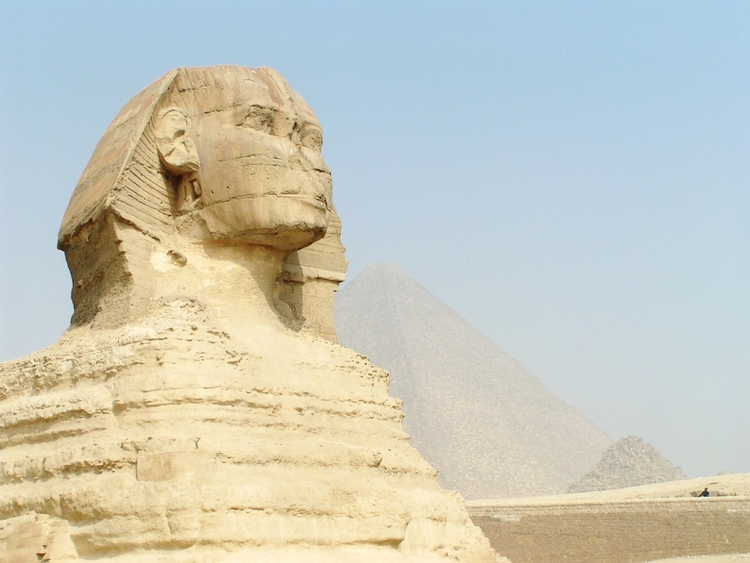
We begin with an 8AM private visit to the Sphinx enclosure. (It is not open to the public.) We spend about 2 hours in the enclosure and around the Sphinx and its adjacent temples. Lots of geology, but this establishes the validity of the ‘Lost Civilization’ theory, important for everything that follows. Also, there are discussions of the many (usually unacknowledged) mysteries involved in building these amazing structures, what lies behind their extraordinary energetic/emotional impact, etc.
We work (walking) our way up the Plateau, past the Old Kingdom tombs of nobles and notables, toward the pyramids. There is more important evidence along the way (e.g. ‘Tomb’ of Khentkaus, a Queen of Menkaure, the builder of the Third Pyramid). Also, because few tourists visit these places, we’re on our own and get a good visceral sense of what Egypt was like in those distant times.
Up on the Plateau, around the pyramids, there is a lot more evidence (architectural and geological) for the ‘Lost Civilization’. We will examine huge, 200 ton paving blocks we could barely move today, etc. Two distinct masonry styles and therefore two distinct building periods…
This takes us to between noon and 1 PM, depending upon how much input we get from group members. There are always lots of questions and if anyone in the group has expertise relevant to and/or complementing my explanations, discussions can be long, lively, detailed and instructive.
Then we visit the so-called Solar Boat of Khufu. This amazing, intact funerary boat, is both a demonstration of the extremely sophisticated woodworking techniques in place 2500 BC and also of the power and wisdom of anchoring the spiritual quest in the material/physical world. As soon as the spiritual Quest is relegated solely to the intellect, as is generally the case today, it becomes abstract and effectively ineffective.
Lunch. (Included.) By now it’s 3 PM, and that’s enough for most of us! Evening is free.
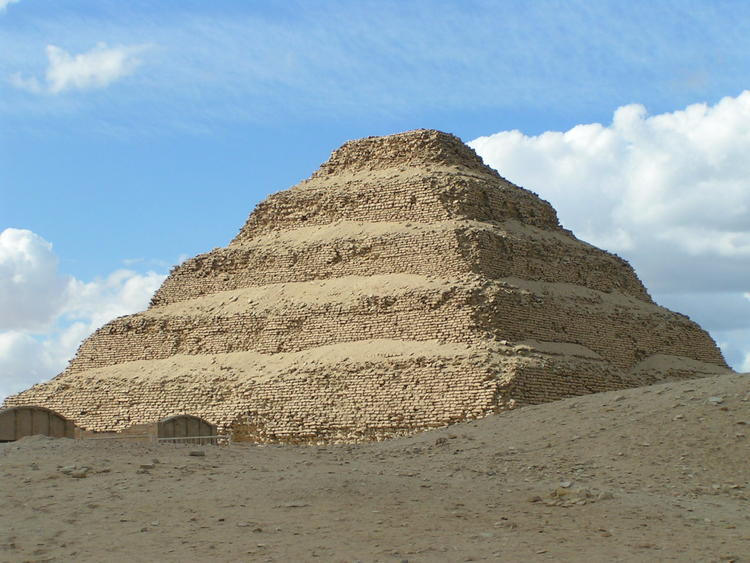

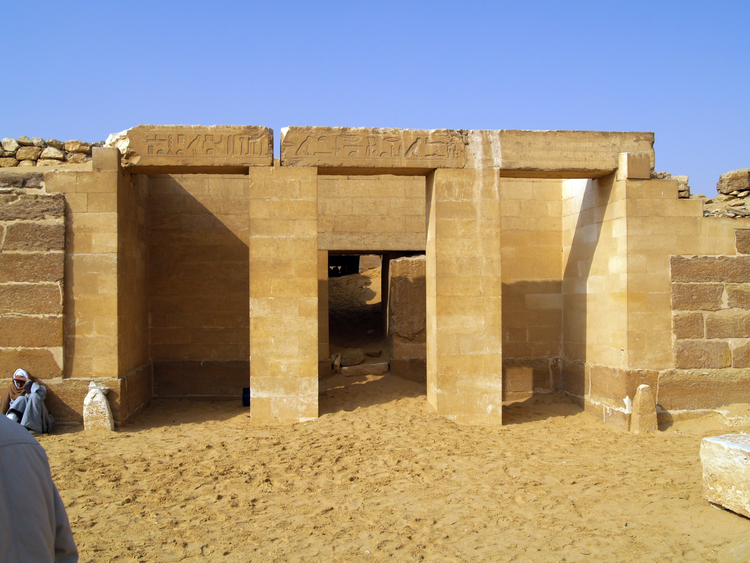
6 AM wake-up call, 7:30 Departure. It is essential to start punctually and get there at opening bell. 20 minute bus ride to the Sakkara Necropolis.
We start with the Old Kingdom Tombs of the Nobles of the Vth and VIth Dynasties (ca. 2350 – 2200 BC), with their vibrant, detailed, but apparently quite mundane ‘scenes of daily life’. They are most assuredly scenes of daily life, but more importantly, they are actually metaphors for transformation. (Even the “Quackademics” are coming around to recognizing this deeper significance, though of course they haven’t a clue as to either the meaning or validity of ‘transformation’).
Sakkara usually gets crowded early so we sometimes have to change our sequence of visits to try to avoid the crowds or even choose alternative tombs to visit.
After the Noble Tombs, we go to and into the Sakkara Step Pyramid Complex itself, built in the reign of the IIIrd Dynasty Pharoah Zoser (ca. 2700 BC), under the direction of his genius Master of All Trades, the legendary Imhotep.
Sakkara is supposed to be the first major stone complex in Egypt, and for that matter, the world, but the sophistication of its plan and the virtuosity of its execution makes it hard to believe that it was invented on the spot — like imagining the 2008 Porsche just happened out of the blue. Nor is it the first major stone complex either. More on this on site! We discuss Egypt as a ‘legacy’ not as a ‘development’.
Sakkara is also remarkably ‘modern’ looking, as though it were a new campus for, say, The University of Arizona, designed by Frank Lloyd Wright on a particularly inspired day. There are reasons for this —
The interior of the Necropolis enclosure was the scene of the Heb Sed festival, which is best understood as an initiatic process; the culmination of a life of inner work, rather than as physical proof that King was fit to go on reigning (the usual explanation). We find more evidence for the ‘Lost Civilization Theory’ (henceforth, LCT) close by the Step Pyramid itself, such as examples of calculated resonance at work in certain strange shrines. The theme of ‘transformation’ is expressed in innumerable metaphors. Egypt is a “One Issue Civilization” — virtually all of its creative energy is devoted to the quest for immortality and the development and perfecting of the soul. In words, this sounds as though Egypt gets repetitive, but actually it doesn’t: any more than successive concerts or baseball games or chess matches are repetitive. The infinite variations complement/implement the exercise. By this time, it’s around noon. Lunch is included at a neat outdoor local restaurant. Great kebabs. After lunch, it’s on to Dahshur, and the Red and ‘Bent’ Pyramids.
The Red Pyramid, with its resonating main chambers and earlier megalithic third chamber (quackademics call this a ‘plundered tomb chamber’. It is neither plundered, nor a tomb chamber) is the second most spectacular pyramid after the Great Pyramid The Bent Pyramid is a generally unrecognized architectural marvel. 60% of the casing blocks are still in place, so you get a sense of what a completed pyramid once looked like, and the construction methods needed to build it defy explanation. If there are any architects or builders in our group, have a go at it. I’ve read that the Bent Pyramid is now, for the first time ever, open to the public. If it is, we’ll go in. A first for me, too! End of the day.
On the way back we stop at a carpet factory/school where they weave prize-winning traditional Oriental Carpets but also, unique to Egypt, woven one-of-a-kind wall hangings depicting local, Islamic and underwater Red Sea scenes. They’re like vivid primitive and often not-so-primitive woven paintings. Good, imaginative work.

We embark on a mid-day or early afternoon (we hope! — as opposed to morning) flight to Luxor. Check into our Nile-side hotel, the Sonesta St. George.
At 6 PM we visit Luxor Temple, where R.A. Schwaller de Lubicz developed his Symbolist Interpretation: the Temple of Man as a cosmological/physiological map.
We discuss and demonstrate what ‘sacred’ architecture is, and just why it works the way it does. By 7:30 or so, the Temple is usually emptying out and we have it nearly to ourselves. In a chamber that represents the vocal chords we see what is in effect a depiction of the ‘Annunciation’, the ‘god’ telling the Queen Mother that she will bear a ‘Divine’ child, 1350 years before this becomes central to Christianity. (All along we will be drawing attention to Egyptian doctrines, myths, and metaphors, that are normally associated with Christian doctrine. Gurdjieff called Egypt ‘esoteric Christianity’.) We could use more time here, but we don’t have it, and getting there earlier is no solution since it’s usually jammed then.
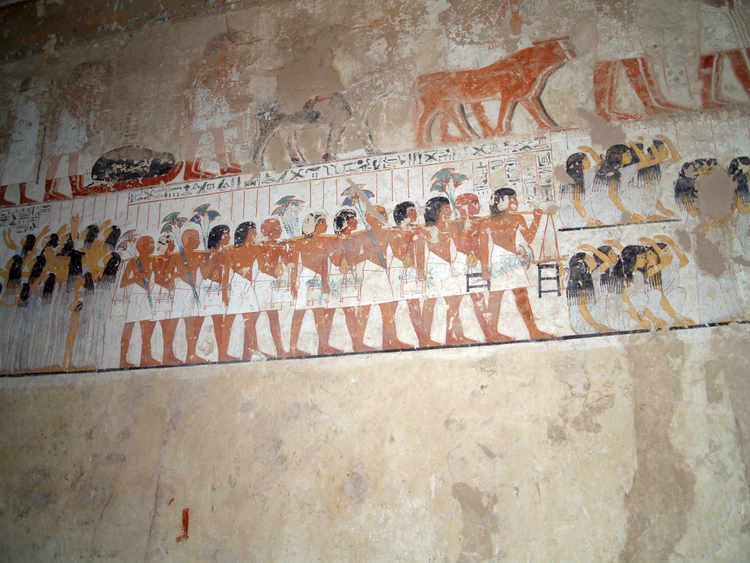
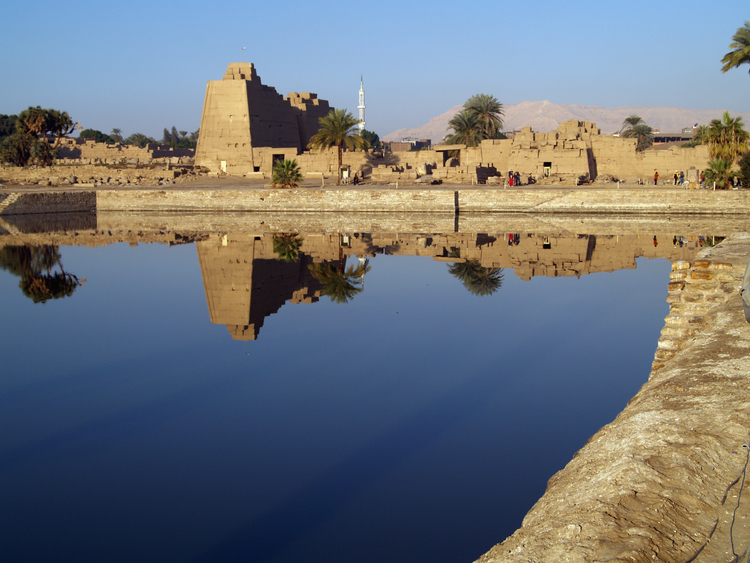

12:30 PM (EST + 7)
40 Minute bus ride.
This area is entirely funerary in significance; here we have the massive funerary complexes of the New Kingdom, the Valley of the Kings, where all NK pharaohs are buried, and the well-preserved tombs of the Nobles — related to those we’ve seen at Sakkara but markedly different in execution and expression. This is a day much devoted to discussions of Egypt’s complex and mysterious funerary beliefs and practices.
If we are mystified, we’re not alone. Even to the New Kingdom Egyptian scribes recording the texts, they are ‘mysterious’, but in the broadest sense they’re comprehensible; they combine the separate but intertwined doctrines: the path of Horus (which becomes the doctrine of ‘salvation’ in Christian doctrine) and the doctrine of reincarnation (corresponding loosely to the Vedic/Buddhist tradition). Since to our own “Church of Progress” both these paths lead nowhere, they are more or less dismissed as mumbo jumbo. But if the Church of Progress priesthood cannot make any sense of them, we can, and the experience of the visit, however, unfamiliar experientially, is nevertheless vivid. Even the to-us-bizarre practice of elaborate mummification starts to make sense.
We visit MEDINET HABU or THE RAMESSEUM (decision to be made last minute). Medinet Habu is both the Alpha and Omega of Egyptian Cosmology. It is here that the Eight Primordials come into existence. These are shadowy entities, both male and female, (portrayed as serpents or frogs) which precede manifestation, and play roles remarkably like the ‘vibrating strings’ of cutting-edge String or Torsion Theory. And is also here that storehouses in ancient times held the finished treasures of Egypt, furniture, unguents, musical instruments, jewelry, etc., in other words the fruits of all that transformational earthly creative activity. Medinet Habu is thus both planting time and harvest time. A little shrine dedicated to the princess Amenerdais, Head of the Chantresses (6th C. BC) was the inspiration for Verdi’s Aida.
The Ramesseum is the mortuary temple of Ramesses the Great, and is less grandiose than the huge Medinet Habu, but very powerful, and it’s here that the fallen colossus lies that inspired (in absentia) Shelley’s famous poem Ozymandias. It’s amusing to read the poem on site; fine poetry but lousy Egyptology.
We visit the great (but controversial) Queen Hatshepsut’s Temple of DEIR EL BAHARI, the other temple with a peculiarly ‘modern’ look to it. To the ancient Egyptians it was ‘the most splendid of all’ — and so it must have been. Even in its present state it’s pretty spectacular.
We have an early lunch at a lovely, typically rustic, outdoor Egyptian local restaurant, and then on to the VALLEY OF THE KINGS, where all the kings of the New Kingdom were buried.
Avoiding crowds in the West Bank is problematical but at lunchtime (for everyone else) we’ll be relatively crowd-free at this otherwise thronged site. And we may be able to get special permission (an extra $10 each and worth it) to the closed but particularly vivid and significant tomb of Ramesses VI.
After the Valley of the Kings, we go back to our East Bank hotel.

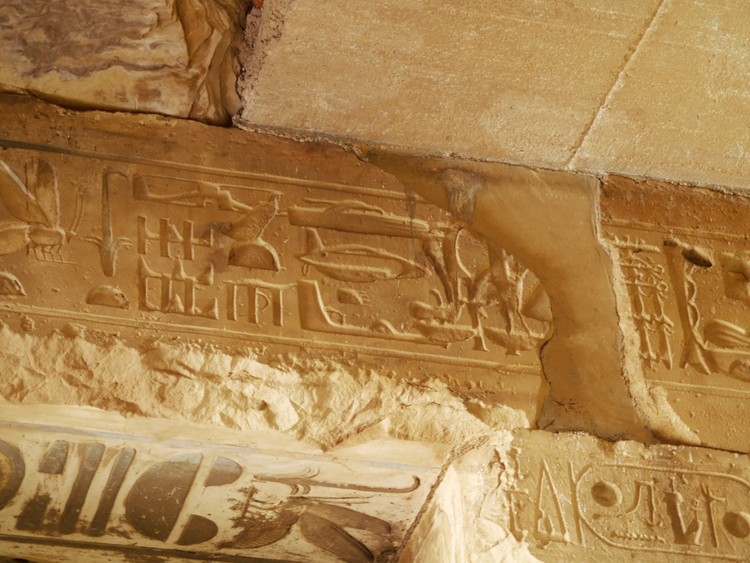
An extremely irritating rule in place for over 10 years, obliging us to visit these two great sites as part of an armed convoy, has recently been lifted. So we’re no longer forced to cut our visit short and we can go and come as we please. This is a serious improvement! But it means an even earlier wake-up call than usual, and ‘usual’ is bad enough. We (discreetly!) pack doggy bags at breakfast since there’s no place en route that we’d want to stop in for lunch, and we need every minute of this long day for the temples.
Abydos, built by Seti I, father of Ramesses the Great, is one of the highest expressions of New Kingdom relief work, most of it in excellent condition, and some with the colors still vibrant. This is an Osiris temple; Osiris representing the cosmic principle of becoming and return, and also of the divinity immanent within humanity. En route to Abydos (2 1/2 – 3 hr drive), I talk at length about the Osiris myth (which, historicized, becomes the central doctrine of Christianity, then the story of Hamlet, and most recently, Disney’s Lion King) and its relevance to our time, and any other time.
Selective effacing of certain reliefs within the temple is always attributed to Christian fanatics, bent upon destroying the temple’s pagan ‘magic’. But it is no such thing. More on this anon and on site. The non-effacement of the temples may be the only crime where Christian fanatics are not guilty as charged.
Behind Seti’s Temple of Abydos there is the Oseirion, one of the most powerful, mysterious, and resonant places of all Egypt, and almost certainly a major piece in the LCT.
DENDERAH TEMPLE
We have our doggy bag lunch en route. The temple is entirely Ptolemaic/Graeco-Roman, (ca. 150 BC – 80 AD) and consecrated to Hathor, the Cosmic Feminine in her roles of Mistress of the Cycles of Time and Mother of the Universe. It’s here that we get our first real taste of what time is doing to Egypt. While the knowledge of geometry/harmony/proportion and measure are still intact, the exquisite and apparently effortless virtuosity of New Kingdom art and sculpture has turned unwieldy, clumsy, and uninspired.
It is a fascinating lesson for us, watching Egypt degenerate and this is the first among many examples. Apart from being an exercise in art history, on the scholarly/philosophical/scientific level, in and of itself, it disproves the egregious fiction we’ve all been brought up with: that history is a fundamentally steady, linear and gradual ascent from primitive beginnings to our enlightened selves with our hydrogen bombs and bobble-head dolls.
In Egypt we see exactly the opposite happening in front of our eyes, and this calls for some serious discussion and in some cases a major revision of certain notions we’ve all had drummed incessantly into our heads in our so-called ‘educational system’.
But re: Denderah, however corrupted the art, the temple retains its power. An inscription in a crypt closed to the public declares that Denderah is based ‘upon a plan found on a goatskin scroll written in the time of the Companions of Horus’, one of the two long, and perhaps-not-fictional periods the Egyptians said preceded the rise of their own Dynastic Egypt. So Denderah would be another good place to go looking for still more evidence for the LCT. Like all ‘goddess’ temples, Denderah was a healing site; a ruinous mud brick structure adjacent to the temple was once a sanatorium where dream analysis was carried out.
While reactions to Luxor Temple and Abydos are invariably very positive, Dendera often gets polarized reviews. For some, despite the inferior art work, it is a favorite temple, a place of profound cosmic peace. For others it is dark and gloomy, even spooky. It will be interesting to test our group’s reaction to see if there is any correspondence to our Enneagram ‘types’.
The wholesale, but obviously selective effacing of the relief work prevailing here demonstrates who is responsible: it is the Egyptian priesthood at some later date and for reasons of their own, effectively ‘decommissioning’ the temple.
We return to Luxor (about an hour’s drive.)
Note: Depending upon local conditions, we do not necessarily visit these sites in the order listed, but we do visit all of them.
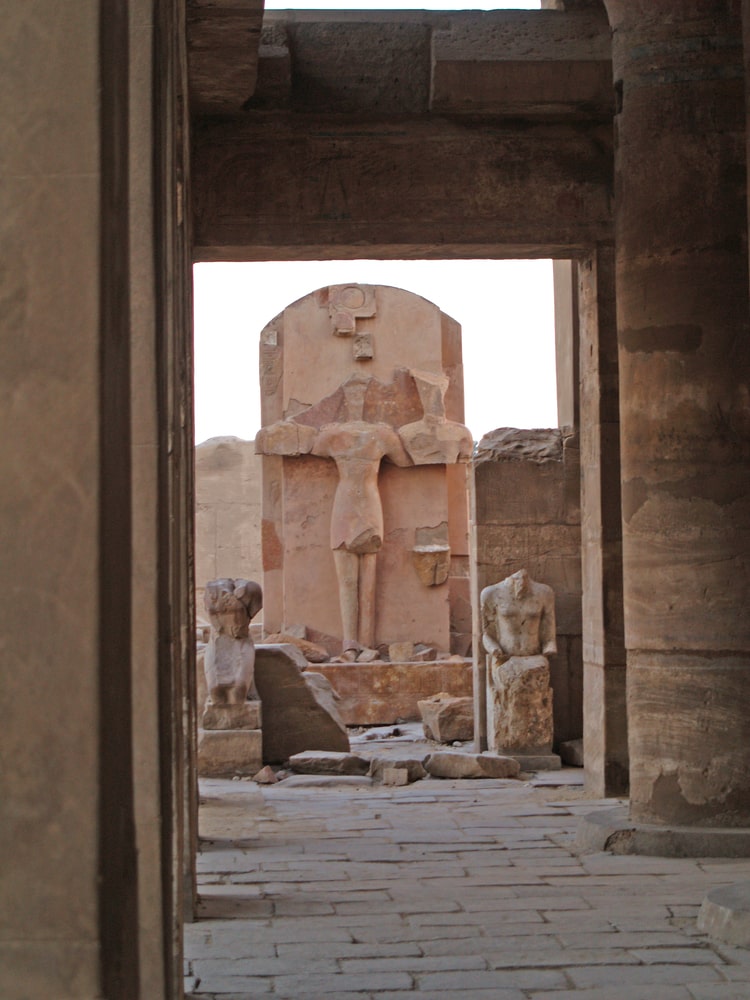
12:30 PM (EST + 7)
— Very early 6 AM visit to the vast KARNAK TEMPLE, consecrated to Amon in his role of animator of form, the ‘breath of life across the waters’.
Each major temple at Luxor represents one stage in their (and our!) cosmology, stages in the genesis of the universe. Huge joyous processions connected one temple to another. So the Egyptians, through an act of conscious deliberate sympathetic magic, were themselves mimicking and therefore participating in the process of creation itself. We can no longer do this — we’ve lost the necessary magic spell to access it — but the power of these temples provides an echo, an inkling, an appreciation of what life had once been like, when a genuine civilization, itself in a cosmologically ordained descending octave, last prevailed.
The Hypostyle Hall at Karnak is one of the architectural wonders of the world, and there is much else there that is both emotionally and spiritually moving, as well as intellectually revelatory. If Luxor is The Temple of Man, Karnak is the Temple of Organic Creation and the Hypostyle Hall symbolizes this with its double banks of 9 x 7 gigantic columns. Enneagrammarians should appreciate the significance of this instantly and perhaps even experience it.
We do a private meditation session in a secluded Sekhmet Shrine in the company of the great Goddess’ granite embodiment. We leave Karnak awed, humbled, exhilarated and — very much looking forward to a late breakfast.
The rest of the day is free (hooray! shopping! Or just much-needed rest) until late afternoon and then we visit the small but beautifully designed, masterpiece-replete Luxor Museum.
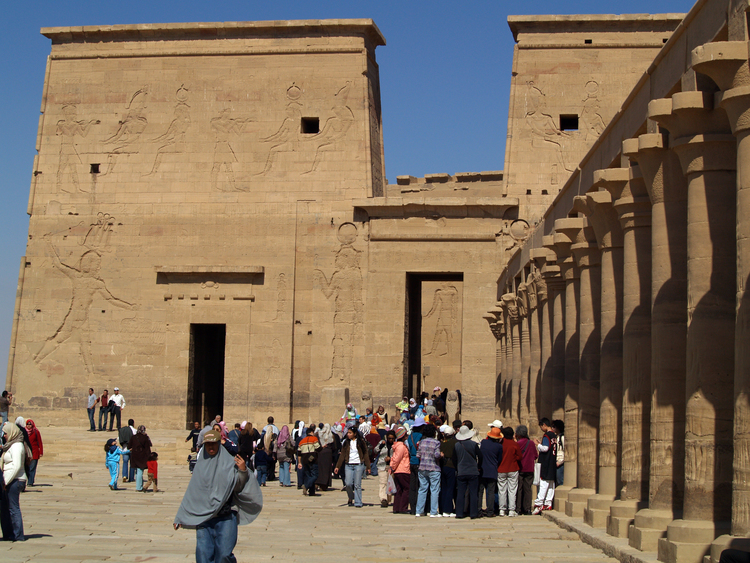
No longer tied to the convoy on this leg of the trip either, we can visit these two interesting Ptolemaic temples en route to Aswan (which wasn’t worth it when we had to go with the convoy). With luck we should be able to schedule our visit at a time of minimum crowds.
Edfu, the best preserved temple of the ancient world, is consecrated to Horus of Behdet; that is, Horus in his specific role of avenger of the murder of his father, Osiris. (That’s Hamlet but without the to-be-or-not-to-be waffling element). It is an appropriately macho and martial temple with many intriguing and important lessons to convey.Kom Ombo is consecrated to the duo of Sobek, the crocodile (Death as a cosmic function) and Horus, the Elder (Return to the Source as a cosmic function). Beautifully sited on a bend of the Nile, but now photogenically ruinous, Kom Ombo was in its day a healing temple and hospital.
Late afternoon arrival in Aswan, check into our Movenpick Hotel — a great place, on an island in the Nile, recently totally and tastefully refurbished. Evening visit for those interested to the thronged, and pulsating Nubian bazaar. Some interesting stuff to buy.
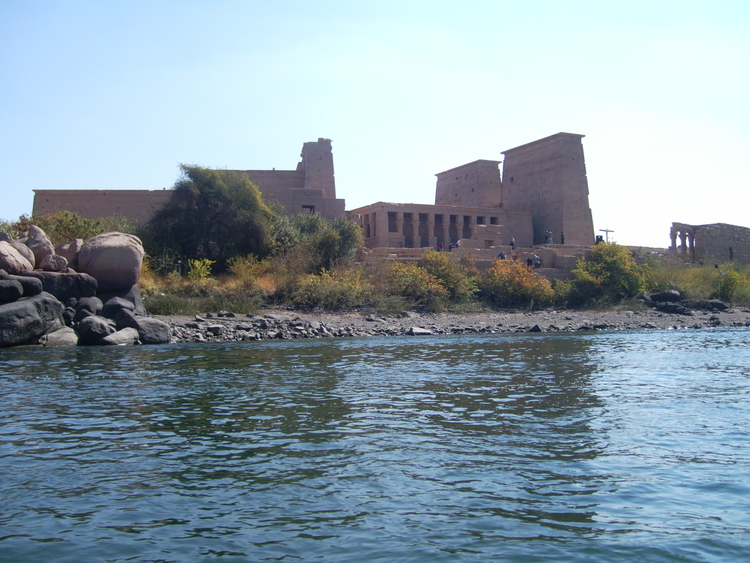
No early wake up call today. Philae Temple is a zoo until midday, so that’s when we go there.
First we go to the UNFINISHED OBELISK at the ancient granite quarries, where a planned, half-excavated 1200 ton single block of granite failed to make it out of the bedrock. Here we get a good taste of Egyptian technology in action, and we believe we can explain here what is next to impossible to convey anywhere else in Egypt: how with very simple tools the Egyptians managed to accomplish what is practically impossible to accomplish even with modern machines — but even so, plenty of mysteries remain.
Then on to PHILAE TEMPLE, consecrated to Isis in her role of Mother of Horus (the Christians changed her name to the Virgin Mary, but she’s Isis, like it or not). Philae is on an island in the middle of the Nile (now it’s the lake backed up behind the British ‘Low Dam’ built in 1904.) Quintessentially feminine, it is one of the most beautiful and moving sites in all of Egypt, despite the relatively inelegant quality of the Ptolemaic relief work and the wholesale, but telling selective defacing. It’s here that the transition of the ancient Egypt doctrine of Immortality segues almost seamlessly into Christianity in front of our eyes.
For the afternoon, an optional felucca ride. These are picturesque, lateen-rigged little sailboats and it’s a gorgeous hour or so sail on the clear green purling waters around the Nile islands. With a stiff wind up it can be pretty exhilarating.

Abu Simbel has always been high on the list of must-see Egyptian marvels, and so it should be, but tightened, paranoid security measures, a dreadful sound and light show, and hundreds of tourists streaming off the new cruise boats plying Lake Nasser between Aswan and Abu Simbel and mooring there in the evening have diminished that Abu Simbel experience. For the last few years I’ve actually removed it from the itinerary, leaving it as an option for those determined to go there no matter what.
However, post-revolution, and with tourism (as this is written) but a fraction of “normal” I’ve put it back on. Though I can’t promise it will be near-empty, it will definitely be worth the 3 hour busride back and forth.
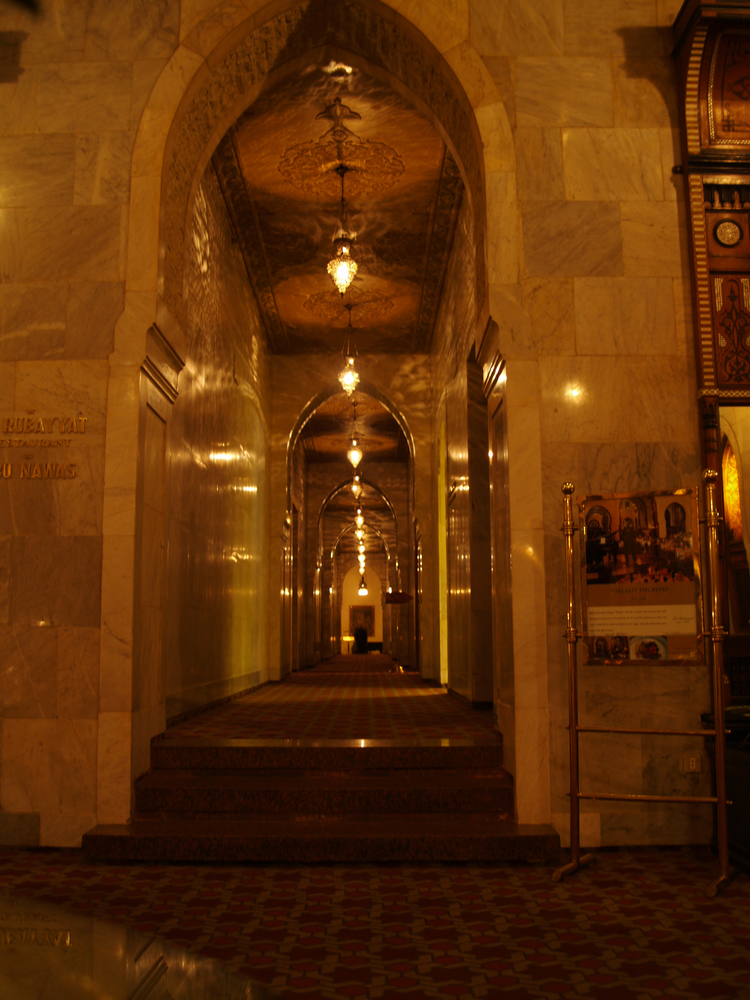
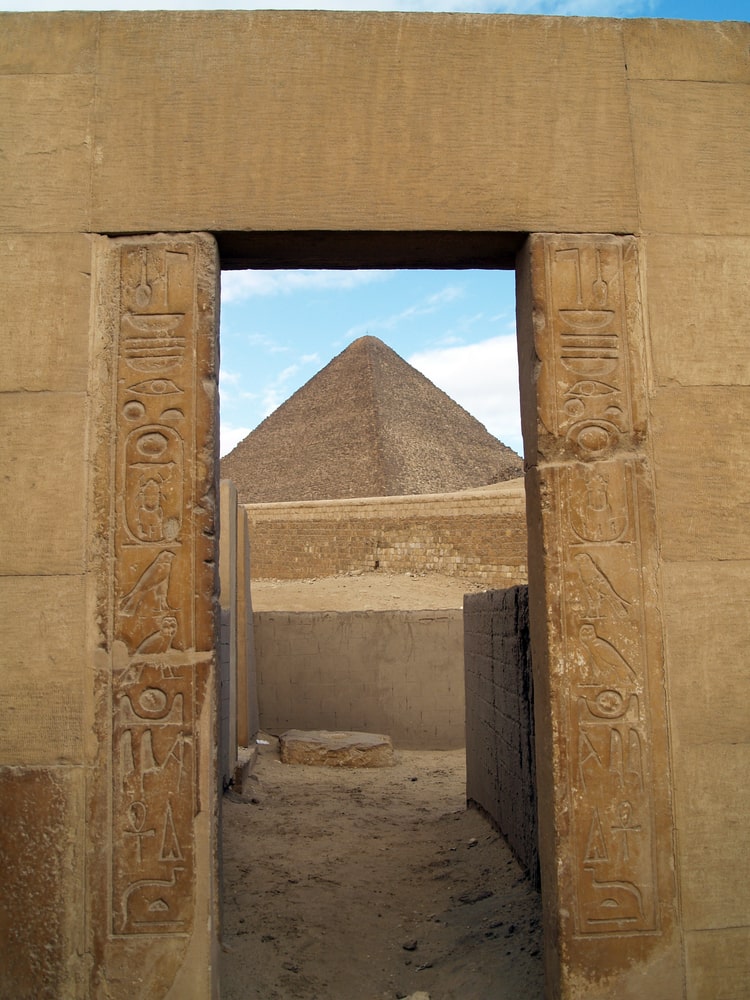

Breakfast followed by final departure.
Adios, Egypt — though if past experience is any indication, for many it will be au revoir!

Recommended Reading There is no single preferred way to prepare for Egypt. Many like to read everythingthey can that’s relevant in advance; others prefer to

General Info & Safety Breaking News: This may be your last chance to see Egypt with John Anthony West This is a test, this is

Tour Itinerary Travel to Egypt on a Magical Egypt Intensive Study Tour with John Anthony West, Emmy award winning writer, researcher, rogue Egyptologist and raconteur.